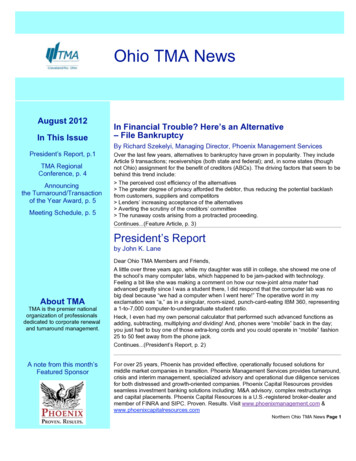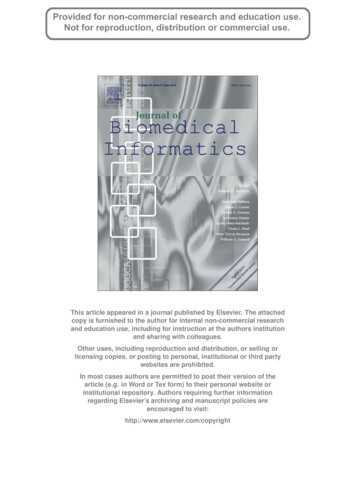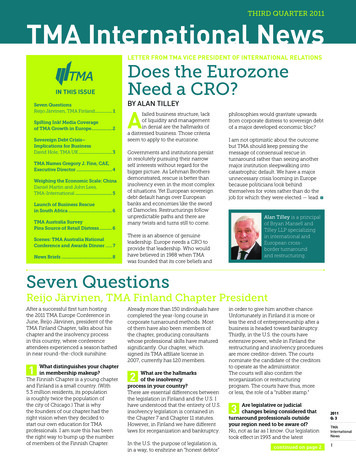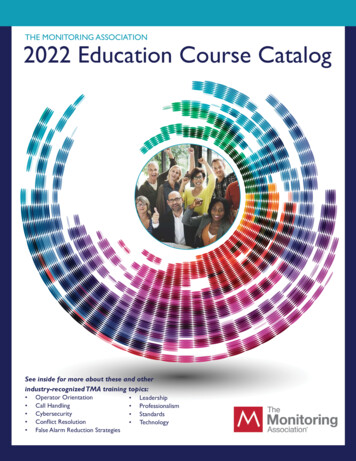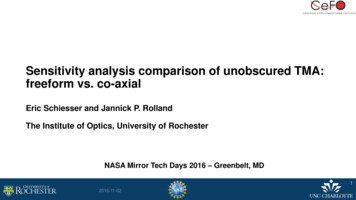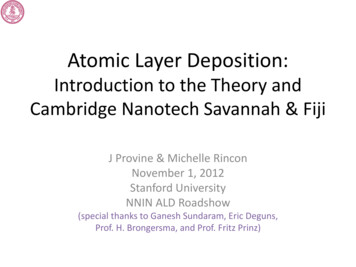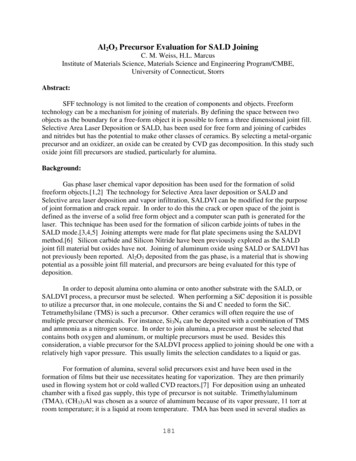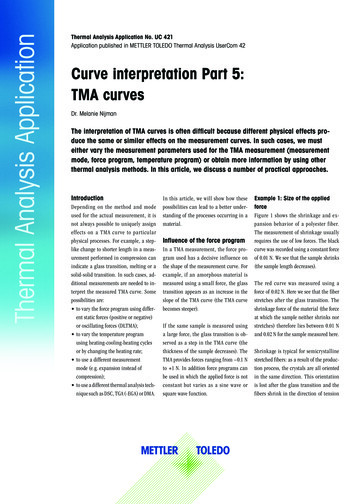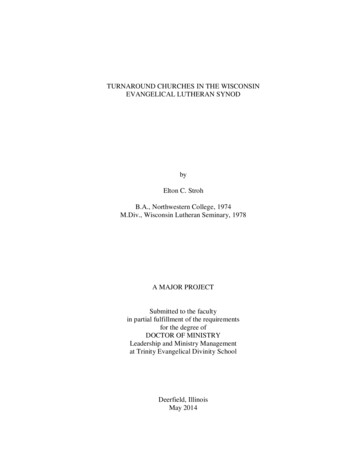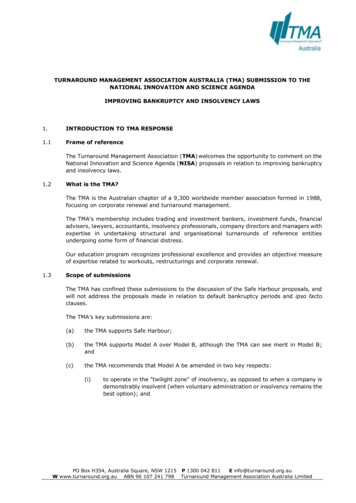
Transcription
TURNAROUND MANAGEMENT ASSOCIATION AUSTRALIA (TMA) SUBMISSION TO THENATIONAL INNOVATION AND SCIENCE AGENDAIMPROVING BANKRUPTCY AND INSOLVENCY LAWS1.INTRODUCTION TO TMA RESPONSE1.1Frame of referenceThe Turnaround Management Association (TMA) welcomes the opportunity to comment on theNational Innovation and Science Agenda (NISA) proposals in relation to improving bankruptcyand insolvency laws.1.2What is the TMA?The TMA is the Australian chapter of a 9,300 worldwide member association formed in 1988,focusing on corporate renewal and turnaround management.The TMA's membership includes trading and investment bankers, investment funds, financialadvisers, lawyers, accountants, insolvency professionals, company directors and managers withexpertise in undertaking structural and organisational turnarounds of reference entitiesundergoing some form of financial distress.Our education program recognizes professional excellence and provides an objective measureof expertise related to workouts, restructurings and corporate renewal.1.3Scope of submissionsThe TMA has confined these submissions to the discussion of the Safe Harbour proposals, andwill not address the proposals made in relation to default bankruptcy periods and ipso factoclauses.The TMA's key submissions are:(a)the TMA supports Safe Harbour;(b)the TMA supports Model A over Model B, although the TMA can see merit in Model B;and(c)the TMA recommends that Model A be amended in two key respects:(i)to operate in the "twilight zone" of insolvency, as opposed to when a company isdemonstrably insolvent (when voluntary administration or insolvency remains thebest option); andPO Box H354, Australia Square, NSW 1215 P 1300 042 811E info@turnaround.org.auW www.turnaround.org.au ABN 96 107 241 798 Turnaround Management Association Australia Limited
(ii)to afford directors a "safe harbour defence" in relation to civil liability actionsbrought against them for breaches of directors' duties in relation to directorconduct during the Safe Harbour period, in addition to the proposed defence forinsolvent trading during Safe Harbour.1The TMA also suggests that there is utility in NISA considering a limitation on the ability of asubsequently appointed liquidator to bring an action against a director for breach of s 588Gor ss 180- 183 of the Corporations Act in circumstances where there is evidence that therequirements of Safe Harbour were properly implemented. However, the TMA recognisesthat a subsequently appointed liquidator should still be able to take action against directorsin circumstances where the liquidator determines that the requisite Safe Harbour steps werenot followed or there were serious matters arising from the directors' conduct prior to SafeHarbour. This is discussed further at 2.5 below.Our responses to each of the queries raised by NISA are set out in sections 2 and 3 below.1.4The TMA supports Safe HarbourThe TMA considers that a distressed business has the best prospects of survival through:(a)early engagement with stakeholders;(b)expert advice from restructuring advisers in the "twilight zone" of insolvency; and(c)the development and implementation of a restructuring plan and/or informal workoutstrategies.Well-known attendant benefits of restructuring, turnaround and business renewal (as opposedto administration or liquidation) include job preservation, protected tax revenue, maintainingenterprise value of the company and preserving the social compact between businesses andthe local community.The TMA considers that informal workouts often have a significant practical advantage overformal procedures in saving businesses, due to their flexibility and efficiency.In this regard, the TMA is in favour of legislative change that promotes the use of these informalmechanisms and provides appropriate protection for directors who actively explore thepossibility of revival of a distressed company at an early stage.The overarching intent of the TMA (and business renewal itself) is that early identification andincreased optionality promote better outcomes, this is complimentary to the prospectivereforms and regulations.1.5The "twilight zone" and timing of turnaround effortsThe TMA considers that the ideal time for turnaround and restructuring of distressed businessesis in the "twilight zone" of insolvency. The concept of the twilight zone is well-known in therestructuring industry, and essentially means the period of time during which there is doubt asto the company's solvency or an imminent risk of insolvency based on cash flow projections orother indicators of financial distress. This may be during a temporary illiquidity period or acrisis event (by way of illustration, an unexpected rather than sustained revenue fall or costs1The TMA notes that where Safe Harbour is properly invoked, as it suggests, in the "twilight zone" of insolvency, a defence to insolvent tradingclaims will not strictly be required. This is because the company will not be "insolvent" at the time of the alleged conduct and therefore aninsolvent trading claim will not be able to be established. However, the TMA recognises the practical incentive and conceptual utility inproviding directors with an insolvent trading defence for proper use of Safe Harbour.PO Box H354, Australia Square, NSW 1215 P 1300 042 811E info@turnaround.org.auW www.turnaround.org.au ABN 96 107 241 798 Turnaround Management Association Australia Limited
increase because of a key person or executive departure, international trade restriction,unexpected change in commodities or currency values or some other occurrence which iscapable of being addressed within the short term by operational, balance sheet or businessmeasures).During the twilight zone the company is not yet strictly insolvent according to its balance sheetor in respect of debts which are currently due and payable; but the circumstances dictate awatchfulness is appropriate given the potential for the situation to force a company to becomeinsolvent. In these circumstances, a properly functioning board should seek to discharge itsduties through the preservation of value by developing a turnaround plan instead of taking thesafer option appointment of an external administrator (in order to avoid insolvent trading risksand personal liability).The twilight zone is precisely the time during which there is the best prospect of restructure orturnaround through informal workout measures (rather than early entry into voluntaryadministration). This is because the company has not yet defaulted on obligations to majorinvestors, bankers or trade counterparties and is not yet associated with the stigma ofinsolvency. The potential for insolvency if nothing is done, often acts as a form of pressure orcatalyst for various parties to work together or form realistic positions to reach an agreement.As such there is a good chance of working with these key stakeholders to find an solution tothe company's liquidity issues and avoid interruption to performance of the company'sobligations to its stakeholders, employees and the community.Importantly, the motivations and economic interest of the restructuring adviser(s) should notbe to encourage insolvency where value preservation may be derived through other options.1.6TMA member survey: views of our members on Safe HarbourIn 2014 the TMA conducted a survey of its members on the topic of insolvency law reform inAustralia. The following comments are intended to provide NISA with the views and experienceof those professionals whose day-to-day practice and business over many years deal withsuccessful turnarounds and resolve business failures. The survey responses from TMAmembers provide an empirical basis to draw the following preliminary conclusions:(a)TMA members are supportive of the introduction of Safe Harbour protections to assistdirectors in developing and executing against a restructuring plan to save the business,either before or as a critical part of triggering the statutory moratorium allowed byvoluntary administration;(b)the present voluntary administration process does not generally cause business failure,in our experience, business failures are mostly caused by bad or untrained management;and(c)there is no great appetite to completely replace the Australian system with the AmericanChapter 11 "reorganisation" model, although there are aspects of the American modelwhich merit consideration, such as:(i)limits being placed on triggering the end of executory contracts by trade and ITsuppliers;(ii)faster sales of business lines; and(iii)preferred financing packaging.The TMA submits the quantitative analysis associated with its survey as Annexure A to thisreport.PO Box H354, Australia Square, NSW 1215 P 1300 042 811E info@turnaround.org.auW www.turnaround.org.au ABN 96 107 241 798 Turnaround Management Association Australia Limited
2.SAFE HARBOUR MODEL A2.1The TMA Supports Model AThe TMA supports Safe Harbour Model A in principle, subject to two key amendments:(a)that Safe Harbour should operate in the "twilight zone" of insolvency rather than whenthe company is already insolvent; and(b)that the Safe Harbour directors' defence be extended civil liability claims againstdirectors for breach of their duties under ss 180-183 of the Corporations Act arising fromacts or omissions of the directors during the Safe Harbour period.These amendments are discussed further below.The TMA considers that Model A is desirable in principle because it requires directors to takeactive steps toward turning the affairs of a company around in order to have the benefit of legallimitations on their liability. The TMA agrees that the involvement of a restructuring adviserwill assist distressed companies to consider informal workout solutions in a flexible manner.Further, Model A directs the minds of directors towards the interests of creditors, which theTMA considers is crucial to facilitating a corporate environment that encourages innovativesolutions for companies in the twilight of insolvency.The TMA also agrees with the emphasis Model A has placed on the maintenance of adequatefinancial records. By requiring the restructuring adviser to have a properly informed opinion,the NISA proposal reflects the purposes of the Corporations Act and facilitates effective andsuccessful turnarounds, with active involvement from companies in distress.2.2Proposal 2.2.1 – The Restructuring AdviserThe TMA agrees that restructuring advisers can, and should, play a crucial gatekeeping role ina Safe Harbour scheme. The onus of selecting appropriate restructuring advisers has beencorrectly placed on directors in the NISA proposal, further recognising that safe harbourfacilitates the continued control of directors, while issues with the affairs of the company areresolved.You will note our use of the plural “restructuring advisers”. This is deliberate. Mostrestructuring situations will need more than one qualified party to advise to reach an optimaloutcome. The larger the size and complexity of the situation, the more likely this is to be true.2.3Suitability of TMA Certified Turnaround Professionals for restructuring adviserappointmentsEvery restructure has a different feature or driver. The most common public restructuresinvolve balance sheet repair or improvements in operational performance (renegotiation ofcontracts with suppliers, change in customer base, changes in banking arrangements, changesin process to build in productivity, changes in workforce allocation, changes in revenueaccounting etc). Often these forms of restructure will involve professionals such as lawyers toadvise on solvency issues, accountants to advise on financial and valuation modelling,investment bankers to seek out sale or refinancing mandates, chief restructuring officers tobetter communicate with key stakeholders such as distressed side bankers. Each of theseprofessional advisers are likely to be members of industry bodies such as the TMA on the basisthat likeminded professionals will gather to share ideas, experiences, techniques and therebyimprove the quality of restructuring advice in the market.Many restructures, though, are of a different kind. Often small and medium enterprises (SME)will face issues around brand, culture, generation change in family businesses, strategic visionPO Box H354, Australia Square, NSW 1215 P 1300 042 811E info@turnaround.org.auW www.turnaround.org.au ABN 96 107 241 798 Turnaround Management Association Australia Limited
and even governance that, once addressed allow a moribund or ailing enterprise to reinvigorateits offering in the market, particularly in the start-up market, being the policy driver of theproposed reform. The advisers to those enterprises may or may not be TMA members, probablywill not be insolvency practitioners represented by ARITA and may or may not operate withinindustry bodies.The TMA accordingly supports the concept of having both identified harbour masters to act asrestructuring advisers and in having the definitional aspect of the restructuring advisery typewide enough to incorporate other disciplines or levels of experience available to the board ofan ailing enterprise. Ultimately, the board should make the decision on what experience isneeded. Ultimately, the board bears the risk of using a non-designated restructuring adviseras harbour master if it turns out a different skillset was needed. Ultimately, though, therestructuring adviser should be chosen by the board to meet the circumstances of turnaroundidentified by the board.The TMA agrees that one of the designated harbour masters, indeed the most effective harbourmaster, will be one accredited or experienced to act as restructuring adviser. This person mayoccasionally be an insolvency practitioner, though will probably most times be someone withbroader business saving skills outside formal insolvency or near insolvency (voluntaryadministration) controllerships. . The TMA's Certified Turnaround Professional accreditedmembers (CTPs) have the necessary qualifications and experience to act as restructuringadvisers. CTP designation is the highest accreditation a turnaround professional can achieve inAustralia. Moreover, it is an accreditation with international standing in the turnaroundindustry, an Australian CTP accreditation being one that comes from licensing and recognitionarrangements with the Turnaround Management Association in the USA.CTP accreditation can only be achieved through completion of post-graduate study designatedby the TMA, compliance with the TMA's strict ethical standards, demonstration of adequaterestructuring experience, provision of references and participation in continuing professionaldevelopment. Further details are provided in Annexure B.CTP accreditation status of a proposed restructuring adviser candidate will provide directorswith comfort that the candidate meets the Minimum Standards (set out and defined in the tablebelow) for appointment as a restructuring adviser.The TMA notes that qualification as a lawyer, chartered/CPA accountant or registered liquidator,without more, will not make a person suitable for appointment as a restructuring adviser.Demonstration of compliance with the Minimum Standards (set out in the table below) will benecessary to qualify a non-CTP for appointment as a restructuring adviser.2.4TMA responses to specific queries on the role and qualifications of the restructuringadviserThe TMA's responses to the specific queries under 2.2.1 are set out in the table below.PO Box H354, Australia Square, NSW 1215 P 1300 042 811E info@turnaround.org.auW www.turnaround.org.au ABN 96 107 241 798 Turnaround Management Association Australia Limited
TMA RESPONSES TO SPECIFIC QUERIES ON THE ROLE AND QUALIFICATIONS OF THE RESTRUCTURING ADVISERThe TMA's responses to the specific queries under 2.2.1 of the NISA enquiry are set out below.RefQueryResponse2.2.1aWhat qualifications and experience directors shouldtake into account when appointing a restructuringadviser?The TMA agrees that a restructuring adviser must be an accredited member of anorganisation, approved by the Minister, with its own disciplinary framework, ethicalstandards and educational framework (Approved Organisation).Should the above factors be set out in ASIC guidanceor regulations?In addition to belonging to an Approved Organisation, the TMA considers that restructuringadvisers must have:(a)expertise in and an understanding of the management, financial/accounting and legalaspects of a restructuring;(b)postgraduate qualifications (or their equivalent) in turnaround, restructuring and/orcorporate renewal; and(c)a demonstrable amount (at least 8-10 years) of actual turnaround/ restructuringexperience;(d)compliance with the code of ethics of the person's relevant accrediting ApprovedOrganisation; and(e)compliance with the relevant ongoing professional development requirements of therelevant accrediting Approved Organisation.(together, the Minimum Standards).The Safe Harbour scheme will rely on distressed companies accessing the skills andexperience of properly qualified restructuring advisers. The TMA therefore considers thatthe above Minimum Standards are essential, and should be prescribed in legislation.We emphasise that all Certified Turnaround Professional accredited members of the TMA(CTPs) meet these Minimum Standards.PO Box H354, Australia Square, NSW 1215 P 1300 042 811E info@turnaround.org.auW www.turnaround.org.au ABN 96 107 241 798 Turnaround Management Association Australia Limited
RefQueryResponseFurther details of requirements for CTP accreditation by the TMA are set out in AnnexureB.2.2.1bWhich organisations should be approved to provideaccreditation to restructuring advisers?The TMA considers that a restructuring adviser must be a lawyer, insolvency practitioner oraccountant duly accredited by an Approved Organisation.The TMA, for the reasons set out above and at Annexure B, agrees that it should be anApproved Organisation.In addition to the TMA, we also support the inclusion of the following organisations in the listof Approved Organisations:(a)a state, territory law or Commonwealth law society;(b)Charted Accountants Australia and New Zealand;(c)CPA Australia;(d)the Australian Banking Association;(e)the Australian Institute of Company Directors; and(f)Australian Restructuring, Insolvency and Turnaround Association.However, mere accounting, or legal qualifications will not make a person suitable forappointment as a restructuring adviser. Further, many registered liquidators will lack skillsin the area of restructuring and turnaround. These skills are very specific and are developedby experience, comparable situations and post graduate study.The TMA therefore re-iterates the importance of the Minimum Standards being prescribed inlegislation, in order to ensure the integrity and success of Safe Harbour.It emphasises that its CTP accredited members are ideally suited to appointments asrestructuring advisers.PO Box H354, Australia Square, NSW 1215 P 1300 042 811E info@turnaround.org.auW www.turnaround.org.au ABN 96 107 241 798 Turnaround Management Association Australia Limited
RefQueryResponse2.2.1cThe proposed test of viability is whether the companycan:The TMA considers that Safe Harbour is most effective if invoked in the twilight zone ofinsolvency, rather than when a company is already insolvent. In this regard, the TMAproposes that the test of viability should be whether, in the opinion of the restructuringadviser:(a)avoid insolvent liquidation, and(b)be returned to solvency within a reasonableperiod of timeIs this an appropriate method of determining viability?2.2.1dWhat factors should the restructuring adviser take intoaccount in determining viability?Should these be set out in regulation, or left to thediscretion of the adviser?(a)the company can avoid insolvent liquidation, and(b)the turnaround plan enables the board of the company to determine that thecompany will be solvent within a reasonable period after completion of SafeHarbour; and(c)the turnaround plan contains periodic check points over the term of the plan for theboard and the restructuring adviser to assess the continuing solvency of thecompany and to consider the interests of all creditors at each check point.The TMA suggests that the factors to be taken into account be broad and involve quantitativeand qualitative assessments of both specific and general issues influencing the company,including levels of debt, internal capacity for change at the labourforce, executive and boardlevels, creditor attitudes and market conditions.The TMA consider that the factors should be left to the discretion of the adviser and notprescribed in the legislation or regulations.2.2.1eThe restructuring adviser would be:(a)(b)appointed by the company, not the directors,and thus owe any duties to the company;required to exercise their powers anddischarge their duties in good faith in the bestinterests of the company and to inform ASICof any misconduct they identify;The TMA considers that the proposed obligations and protections are appropriate andreasonable, subject to the following qualifications:(a)that the protection from civil liability afforded to restructuring advisers be rigorous,so as to avoid the safe harbour reforms becoming a mechanism by which liability,or fear thereof, is simply shifted from directors onto advisers; and(b)the protection be extended to include a person appointed by the company underthe designation "chief restructuring officer" or "chief transformation officer" (orsimilar) and predominantly performing the functions of a restructuring adviser asdefined in the Corporations Act.PO Box H354, Australia Square, NSW 1215 P 1300 042 811E info@turnaround.org.auW www.turnaround.org.au ABN 96 107 241 798 Turnaround Management Association Australia Limited
RefQueryResponse(c)not be civilly liable to third parties for anerroneous opinion provided that it washonestly and reasonably held;(d)unable to be appointed in any subsequentinsolvency without the leave of the Court; and(e)specifically carved out of the expandeddefinition of director contained in the Act (i.e.would not be a shadow or de facto director).Are these appropriate protections and obligations?PO Box H354, Australia Square, NSW 1215 P 1300 042 811E info@turnaround.org.auW www.turnaround.org.au ABN 96 107 241 798 Turnaround Management Association Australia Limited
2.5Proposal 2.2.2 – Directors' Defence under Safe Harbour(a)Scope of the DefenceThe TMA agrees that Safe Harbour should operate as a defence to the insolvent tradingprovisions contained in s 588G of the Corporations Act. However, the TMA notes that,as a technical point, where Safe Harbour is invoked early and as proposed by the TMA,in the "twilight zone" of insolvency (ie. when a company is not actually insolvent), nodefence to the insolvent trading provisions will be necessary. This is because theelements of an insolvent trading claim (ie that the company was insolvent at the relevantdate) will inherently not be able to be established.That said, the TMA recognises the conceptual importance of establishing a Safe Harbourdefence for directors, in order to promote the use of Safe Harbour and incentivisedirectors to engage a restructuring adviser as and when required. It is important thatdirectors who appropriately pursue restructuring opportunities under Safe Harbourreceive a degree of comfort as to their legal liability for decisions made during the SafeHarbour period. This will encourage the use of informal workout mechanisms, which inthe opinion of the TMA, often have a practical advantage over formal procedures insaving businesses – due to the flexibility and efficiency of these approaches.Having regard to the importance of providing directors with comfort as to their legalliabilities in utilising Safe Harbour, the TMA also considers that proper compliance withthe requirements of Safe Harbour should also operate as a defence to civil claims againstdirectors for alleged breaches of directors' duties under ss 180-183 of the CorporationsAct during the Safe Harbour period (together, Directors' Duties Claims), so long asdirectors follow the plan developed by the restructuring adviser, with any amendmentsagreed by the restructuring adviser to fit evolving circumstances. The risk of Directors'Duties Claims is also a motivating factor for directors to invoke the safety of voluntaryadministration at an early stage, and hand over responsibility for the affairs of thecompany to an external administrator without attempting a restructure. This is amindset that, in the view of the TMA, requires legislative intervention to shift.To go one step further, the TMA also suggests that consideration should be given to theimposition of a limitation on the ability of a subsequently appointed liquidator to bringany proceeding against directors for breach of duty under ss 180-183 or s 588G, wherethere is evidence that those directors have fully complied with the regulations in relationto the navigation of the Safe Harbour. While a defence is a useful tool to promote theuse of Safe Harbour, it may be cold comfort to directors (particularly directors of SMEsand start-ups) who are not properly insured or otherwise cannot afford to take the riskof being sued and being required to legally defend their conduct. A limitation on theavailability of an action against directors who invoke Safe Harbour, would providedirectors with a greater degree of comfort in invoking Safe Harbour, and greatly increasethe incentive for directors to appropriately use Safe Harbour. However, the TMArecognises that a subsequently appointed liquidator should still be able to take actionagainst directors in circumstances where the liquidator determines that the requisiteSafe Harbour steps were not followed or there were serious matters arising from thedirectors' conduct prior to Safe Harbour.The proposed Safe Harbour defences are essentially an extension of the "businessjudgment rule" under s 180(2) of the Corporations Act, and in the TMA's view isappropriate in circumstances where the legislature is seeking to enact meaningfulchange to the way companies approach the twilight zone of insolvency.PO Box H354, Australia Square, NSW 1215 P 1300 042 811E info@turnaround.org.auW www.turnaround.org.au ABN 96 107 241 798 Turnaround Management Association Australia Limited
The TMA considers, however, that it is appropriate for directors to remain liable unders 596AB with respect to employee entitlements, and for unreasonable director relatedtransactions under s 588FDA.(b)Elements of the DefenceThe TMA considers that the steps a director must take in order to receive the benefit ofa defence to the insolvent trading provisions contained in s 588G of the Corporations Actand Directors' Duties Claims during the Safe Harbour period should be set out in thelegislation.In the TMA's view the director should have a defence under ss 558G and to the Directors'Duties Claims relating to conduct of the director during the Safe Harbour period, if thedirector:(i)appoints a restructuring adviser or restructuring advisers (with the qualificationsand experience mandated by the legislation and regulations);(ii)provides the restructuring adviser with appropriate books and records within areasonable period of their appointment to enable them to form a view as to theviability of the business; and(iii)takes reasonable steps with respect to the affairs of the company:(A)in the interests of the company's body of creditors as a whole;(B)in the interests of its members;(C)based on the advice provided by the restructuring adviser,during the "Safe Harbour period".(c)What is the "Safe Harbour period"?The Safe Harbour period should commence when the director appoints a restructuringadviser, and ends when either:(i)the restructuring adviser forms the view that the company is not viable;(ii)the appointment of the restructuring adviser is terminated for any reason,including but not limited to the successful restructure, workout or turnaround ofthe company;(iii)the company is placed into voluntary administration, liquidation or receivership;or(iv)maintain records in relation to the entry into safe harbour and the conductthereof.(d) What are the "reasonable steps" a director must take?The TMA considers that the "reasonable steps" which a director must take in order toavail himself/herself of the relevant defences should be broadly defined by regulations.Such "reasonable steps" should include:PO Box H354, Australia Square, NSW 1215 P 1300 042 811E info@turnaround.org.auW www.turnaround.org.au ABN 96 107 241 798 Turnaround Management Association Australia Limited
2.6(i)considering the appointment of joint and several restructuring advisers havingregard to the nature and size of the company or corporate group in distress;(ii)working with the restructuring adviser to develop and implement a restructuringplan;(iii)maintaining records of the conduct of the Safe Harbour;(iv)ongoing monitoring of the company's financial position and the viability of therestructuring plan; and(v)participating in and facilitating discussions between the restructuring adviser andmajor creditors, financiers, shareholders and other stakeholders with respect tothe restructuring plan and other informal work out options.Privacy vs Continuous Disclosure ObligationsIn response to query 2.2.2b, the TMA agrees that privacy is often an important factor in thesuccess of informal workouts as involving the stigma of insolvency is key to maintaining theongoing business relationships that will ultimately allow the company to trade-on.However, the TMA recognises the importance of continuous disclosure obligations and alsoagrees that such obligations should not be relaxed on entry into Safe Harbour arrangements.2.7Proposal 2.2.3 – Where Safe Harbour defence will not be available to directorsThe TMA considers that t
PO Box H354, Australia Square, NSW 1215 P 1300 042 811 E info@turnaround.org.au W www.turnaround.org.au ABN 96 107 241 798 Turnaround Management Association Australia Limited (ii) to afford directors a "safe harbour defence" in relation to civil liability actions brought against them for breaches of directors' duties in relation to director
